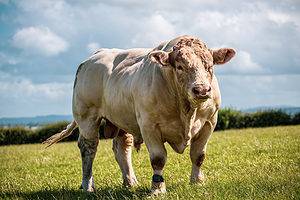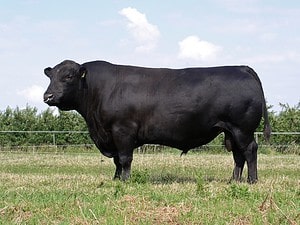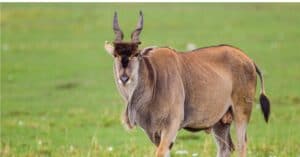Why are cows revered in India? A simple question, yet one that leads us down labyrinthine and brambly trails of religious, cultural, and even ecological complexities. This isn’t just a matter of traditional respect for a docile animal. The veneration of cows in India is deep and ancient. The subject intersects with religious practices, legal systems, and increasingly, global ecological concerns. As the world grapples with escalating climate change, understanding the sanctity of cows in India takes on a particular salience. Here, we have a bovine lens in which to explore both the deep past and the horizons beyond the pastures.
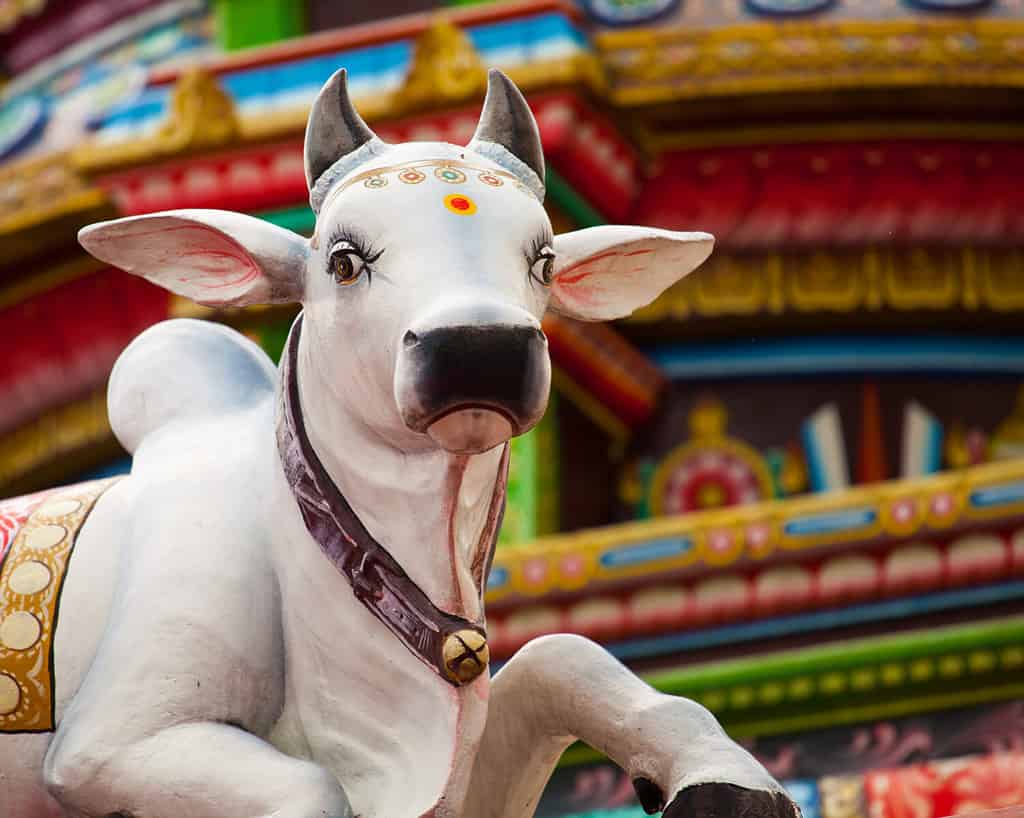
Hindu temples across Asia, and more recently across the globe, feature holy cows. Pictured here is the sacred cow statue at the Sri Mariamman Temple in Singapore.
©SimonHS/Shutterstock.com
Holy Cow Historical Significance
The aura of reverence surrounding cows in India has deep historical roots that trace back thousands of years. During the Vedic period, approximately between 1500 and 500 BCE, cows held a position of considerable importance in society. Beyond their role as a source of milk and dairy products, these animals were considered wealth incarnate. They served as a living currency, if you will. The Rigveda, one of the oldest sacred texts, is sprinkled with hymns extolling the virtues of cows. This positioned them as an asset that rivaled gold in its desirability.
Singing the Praises
But the relationship between humans and cows was not merely transactional. The intertwining of cows with Vedic rituals cast them in a light that transcended their economic utility. They became symbolic of non-violence, purity, and spiritual elevation. Priests, known as Brahmins, included cows in intricate ceremonies, and legends emerged, positioning cows as the abode of multiple deities. With each passing era, the cow’s status shifted from an economic asset to a divine creature. This set the stage for its complex role in modern India.
HYMN XXVIII. Cows.
1. THE Kine have come and brought good fortune: let them rest in the cow-pen and be happy near us.
Here let them stay prolific, many-coloured, and yield through many morns their milk for Indra.
2 Indra aids him who offers sacrifice and gifts: he takes not what is his, and gives him more thereto.
Increasing ever more and ever more his wealth, he makes the pious dwell within unbroken bounds.
3 These are ne’er lost, no robber ever injures them: no evil-minded foe attempts to harass them.
The master of the Kine lives many a year with these, the Cows whereby he pours his gifts and serves the Gods.
4 The charger with his dusty brow o’ertakes them not, and never to the shambles do they take their way.
These Cows, the cattle of the pious worshipper, roam over widespread pasture where no danger is.
5 To me the Cows seem Bhaga, they seem Indra, they seem a portion of the first-poured Soma.
These present Cows, they, O ye Indra. I long for Indra with my heart and spirit.
6 O Cows, ye fatten e’en the worn and wasted, and make the unlovely beautiful to look on.
Prosper my house, ye with auspicious voices. Your power is glorified in our assemblies.
7 Crop goodly pasturage and be prolific drink pure sweet water at good drinking places.
Never be thief or sinful man your matter, and may the dart of Rudra still avoid you.
8 Now let this close admixture be close intermingled with these Cows,
Mixt with the Steer’s prolific flow, and, Indra, with thy hero might.
Rig Veda, tr. by Ralph T.H. Griffith, [1896], at sacred-texts.com
Religious and Cultural Dimensions
Cows in India inhabit the spiritual and cultural imaginations of its people. As an integral part of Hindu mythology, cows are said to be the embodiment of Aditi, the mother of all gods. This celestial link places them in the heart of religious rituals and daily worship. Step into an Indian household during Diwali or Pongal, and you might find cows adorned with colorful garlands, their foreheads painted with sacred symbols. These honored guests and divine emissaries bless the most significant of India’s festivities.
But it’s not just Hinduism that organizes their cultural practices around this bovine core. Jainism, another significant religion originating from India, also advocates for cow protection based on its broader philosophy of non-violence and respect for all living beings. In essence, the veneration of cows in India transcends individual beliefs and even cuts across various religious communities.
Utilitarian Aspects of Cows in India
Yet, the relationship between humans and cows in India is not solely anchored in spirituality. It’s grounded in pragmatism as well. Cows are workhorses, so to speak. In the agricultural landscape of rural India, cows are indispensable for plowing fields. Additionally, their dung serves as a vital, eco-friendly fuel source. As milk producers, they contribute significantly to the dairy industry, which plays an outsized role in India’s economy. Simply put, cows are utility animals with divine attributes, a rare combination that underscores their multifaceted importance in Indian society.
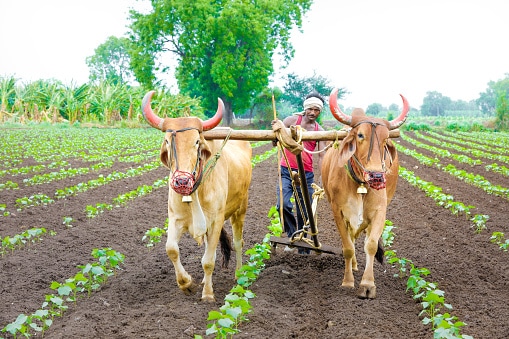
A recent twist in the holy cow saga is that indebted rural farmers are turning away from modern pesticides and expensive equipment in favor of a cow-centric way of farming, which likely had something to with why humans started worshipping cows in the first place.
©Nikhil Patil/iStock via Getty Images
Legal Aspects of Cows in India
In modern India, the cow’s revered status has made its way into the halls of justice. Various states have enacted laws prohibiting cow slaughter, each with its own set of penalties and exceptions. But these laws are not without controversy. They’re often the epicenter of societal debates that bring into question religious freedom, economic implications, and the ever-pressing issue of climate change. While the intent behind cow protection laws may resonate with religious and cultural sentiments, their impact is far-reaching. These laws often affect farmers, meat industry workers, and environmental activists alike.
Plant-Based Alternatives: When Cows are Sacred, What’s on the Plate?
In India, where cows are revered as sacred animals in Hindu culture, the dynamics surrounding beef consumption are entirely different. As noted above, many states in India have laws that prohibit the slaughter of cows, making beef a rare commodity. Inside this socio-legal tangle springs a timely and wide-ranging question. Could India’s cultural and religious practices offer a blueprint for a more sustainable relationship with meat consumption in the age of climate change?
Old-School New-School
Enter plant-based alternatives. Already a staple in Indian diets, legumes like lentils, chickpeas, and various kinds of beans have long served as rich sources of protein. Couple that with an array of vegetables and grains like millets and rice. India’s culinary scene offers an encyclopedia of vegetarian dishes, from hearty dals to sizzling paneer tikkas. These meatless options are not just steeped in tradition. They are increasingly viewed as viable alternatives for those concerned about the environment.
Private Sector Plant-Based Products
Internationally, companies like Beyond Meat and Impossible Foods are advancing the frontier with plant-based products. They mimic the texture and flavor of beef, presenting sustainable and tasty alternatives. Through innovations in food technology, they challenge the status quo. This creates a roadmap for a future less reliant on traditional animal agriculture. Their endeavors reflect a growing consciousness about the environmental impacts of food choices. With luck, they will usher in a wave of culinary creativity that harmonizes with the rhythm of nature. While these innovations are still gaining ground in India, local entrepreneurs are taking up the challenge. Brands like GoodDot and Veggie Champ offer plant-based meat substitutes tailored to Indian palates, reimagining traditional dishes without relying on animal products.
In a nation where cow protection holds cultural and legal sanctity, the gravitation towards plant-based alternatives emerges less as a radical shift and more as a reconnection to roots. Yet, it transcends mere heritage, embodying a vision of future-proofing. These meat alternatives pave a path to diminishing greenhouse gas emissions and curtailing land use. They align seamlessly with global endeavors to mitigate climate change, weaving a narrative of culinary tradition intertwining with modern-day environmental mindfulness.
What makes the Indian context unique is the already-established culinary framework that supports a less meat-centric diet. As the global consciousness sharpens around the environmental cost of beef consumption, India’s bountiful array of plant-based dishes extends beyond a feast for the senses. It unfolds as a blueprint for sustainable living, where culinary delight meets ecological prudence. Through the lens of India’s rich vegetarian tradition, a glimpse into a sustainable dietary future becomes vivid, blending ancestral wisdom with contemporary environmental cognizance.

Beef’s carbon footprint top by multiples other animal-based protein. When compared to a non-animal protein like tofu, we see a 25-fold increase in emissions.
©newannyart/iStock via Getty Images
A New Pretender Contender: Lab-Grown Meat and the Future of Food
Imagine sinking your teeth into a juicy burger and savoring every bite. Then you discover that the meat on your plate never came from a farm or field, but from a lab. Welcome to the brave new world of lab-grown meat. This industry stands on the cutting edge of ethical and environmental solutions for meat consumption. Originating from the microscopic cells of living animals, this meat is nurtured to maturity in labs. It aims to offer the savory satisfaction of traditional animal products, minus the moral and ecological baggage. Unveiled to the world in 2013 by a Dutch team of scientists, this revolutionary concept has since ignited a burgeoning industry. It’s an industry brimming with both promise and challenges.
From refining the texture to cracking the code on taste, lab-grown meat is a work in progress. The usual financial and logistical hurdles contribute to slow and incremental progress. Yet, it’s really the “ick factor” that erects a brain-body Berlin Wall, hindering wider adoption. The world grapples with the intricate clashes of tradition and sustainability. Be it in the cow-protected pastures of India or the meat aisles of supermarkets, lab-grown meat challenges us. It provokes a reconsideration of the very future of food.
The Climate Change Connection: Beef’s Hefty Footprint
Beyond cultural considerations, beef production demands a lot of resources. When scaled up, it becomes an environmental concern with two main issues at its core: the release of methane gas and changes in land use.
Why Methane Matters
Methane, a greenhouse gas, takes center stage in this ecological drama. It’s 34 times more potent than carbon dioxide over a century. Now, if you compare the greenhouse gas emissions from various meats, beef takes the lead, belting out an astonishing 110 pounds of greenhouse gases for every 3.5 ounces of protein produced. To put it in perspective, generating 1 kilogram of beef releases a staggering 70 kilograms of emissions. In contrast, a kilogram of wheat accounts for only 2.5 kilograms of greenhouse gases.
Methane, a formidable greenhouse gas, takes the spotlight in this environmental narrative. Over a 100-year period, it’s 34 times more damaging than carbon dioxide. When examining greenhouse gas emissions across different types of meat, beef emerges as the chief offender. Astonishingly, it releases 110 pounds (about 50 kilograms) of greenhouse gases for every 3.5 ounces (approximately 100 grams) of protein produced. To offer some perspective, generating 2.2 pounds (1 kilogram) of beef spews out a jaw-dropping 154 pounds (70 kilograms) of emissions, while the same weight in wheat is responsible for just 5.5 pounds (2.5 kilograms) of greenhouse gases.

With nearly 60 percent of the world’s agricultural land used for beef production, the logical development of factory farms addressed the dwindling availability of agricultural land, but put to the forefront questions surrounding cruelty to animals and ethical and moral dilemmas as to what personhood means when research tells us more and more about the intelligence and internal lives of non-human species.
©Dieter Hawlan/iStock via Getty Images
Land-Use Matters
Yet, the tale doesn’t end with emissions. Another pivotal issue is land-use change, particularly the aggressive deforestation to create pasture lands. Imagine ancient, lush rainforests like the Amazon being decimated to provide grazing space for cattle. These actions do more than just ramp up atmospheric greenhouse gas levels; they also shred the intricate tapestry of biodiversity that these rainforests sustain.
Global statistics also paint a grim picture. The United Nations Food and Agriculture Organization reported that over a third of global greenhouse gas emissions in 2021 originated from our food system. Shockingly, livestock alone contributed to around half of these emissions.
But it’s not all doom and gloom. Emissions intensity from beef production can be a moving target. It varies considerably by region and is susceptible to mitigation through improved agricultural practices. Optimizing animal feed, embracing more efficient livestock breeds, or employing smarter land management like rotational grazing are some actionable steps. These measures can temper beef’s environmental toll, aligning livestock farming with a more sustainable footprint. Each stride, whether big or small, paves the way towards reconciling traditional agriculture with modern-day environmental imperatives.
So, what are our options? A good starting point could be to dial back on beef consumption, favoring other proteins such as chicken or plant-based alternatives. Additionally, investing in research, be it to refine cattle farming methods or to innovate beef substitutes, is crucial for carving out a future where our plates are as sustainable as they are satisfying. Yes, we really can have our beef and it too.
Global Beef Consumption: The High Stakes of Steak
Beef isn’t just a meal; it’s a global craze. From American grills to British Sunday roasts and Argentine asados, beef’s global footprint is immense. Yet, its ubiquity comes with environmental consequences. As developing nations grow more affluent, their hunger for beef rises, fueling economic growth but straining our planet. The challenge before us is clear: Can we balance this worldwide beef infatuation with the pressing imperative to fight climate change?
Cultural Practices and Tensions: Navigating the Beef Divide
Beef is more than just protein; it’s a potent cultural and religious symbol. In many Western countries, a juicy steak epitomizes prosperity. Contrast this with places like India, where Hindu practices make beef a touchy subject. Ethical and environmental considerations are also prompting particularly the younger generations to rethink age-old customs.
But reducing beef consumption isn’t straightforward. When governments and organizations advocate for more sustainable diets, they often run into resistance. Why? Because these initiatives can be perceived as attacks on cultural identity.
Conclusion: Sacred, Sustainable Survival
The veneration of cows in India highlights that our beef consumption reflects more than just taste; it mirrors our values, cultural respect, and commitment to sustainability. The cow serves as a symbol and real-world example of the multifaceted choices we face.
As we progress, each decision we make, from sustainable farming to exploring alternative meats, carries global impact. The aim, whether inspired by India’s sacred cows or the search for eco-friendly options, is harmonious coexistence that respects both cultural legacy and planetary health. These revered cows prompt us to blend ancient wisdom, humane and ethical practices, and modern innovation for a sustainable future.
Summary Tables
Table 1: Countries With the Highest Levels of Beef Consumption Per Capita
| Country | Annual Beef Consumption per Capita (lbs/kg) |
|---|---|
| Argentina | 79.4325.96 lbs / 36.03 kg |
| United States | 57.23 lbs / 25.96 kg |
| Brazil | 53.86 lbs / 24.43 kg |
| Israel | 53.15 lbs / 24.11 kg |
| Chile | 48.13 lbs / 21.83 kg |
Data source: OECD (2023), Meat consumption (indicator). doi: 10.1787/fa290fd0-en (Accessed on 15 October 2023)
Table 2: Share of Global Beef Consumption by Country
| Region | Percentage |
|---|---|
| United States | 20% |
| China | 13% |
| European Union | 13% |
| Brazil | 13% |
Data source: https://aei.ag/2017/04/17/global-beef-trends-china-brazil-spotlight/
Table 3: Beef vs. Alternatives: A Nutritional and Environmental Comparison
| Protein Source | Protein Content (per 100g) | Greenhouse Gas Emissions (kg CO2e per kg) | Water Usage (liters per kg) | Key Takeaway |
|---|---|---|---|---|
| Beef | 26g | 110 lb (50kg) per 3.5oz | 15,000 – 30,000 | Most environmental impact |
| Chicken | 31g | 5.7kg | 3,500 – 4,300 | Lower impact than beef |
| Tofu | 8g | 0.7 – 2.0kg | 300 – 1,000 | Lowest GHG emissions and water usage |
| Plant-Based Alternatives | Varies (~20g per 4oz patty) | 0.7 – 2.0kg | 72% – 99% less than beef | Comparable to tofu; varies by |
Data Sources: GFI, ScienceDirect, BBC.
Table 4: Cultural Practices Involving Beef
| Culture/Religion | Significance of Beef | Restrictions/Prohibitions |
|---|---|---|
| Western Society | Symbol of prosperity | None |
| Hinduism | Sacred, not to be consumed | Strict prohibition on consumption |
| Judaism | Consumed if Kosher | Must be slaughtered in a specific way |
| Islam | Consumed if Halal | Must be slaughtered in a specific way |
| Buddhism | Generally avoided | Many Buddhists refrain from eating beef |
The photo featured at the top of this post is © Aleksandar Todorovic/Shutterstock.com
Thank you for reading! Have some feedback for us? Contact the AZ Animals editorial team.




